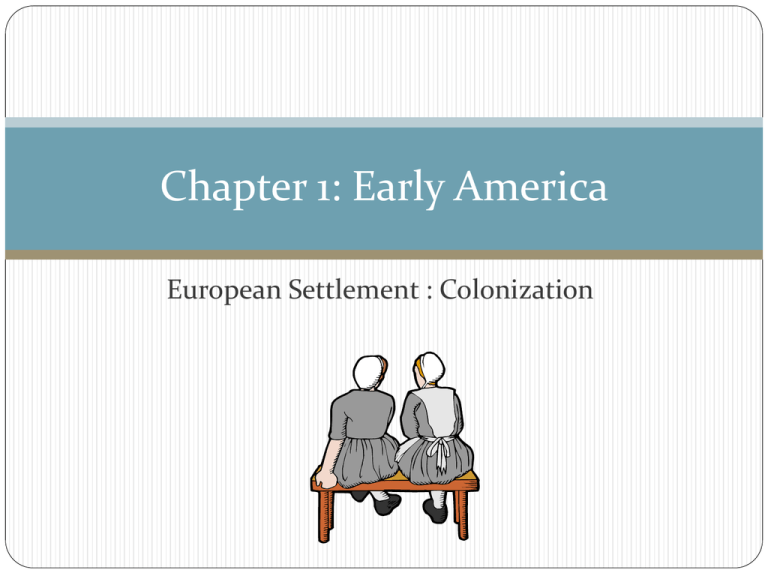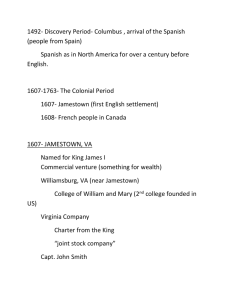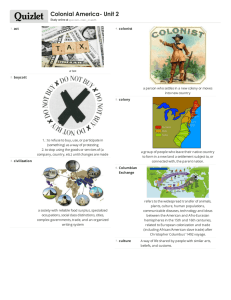Colonization 2015
advertisement

Chapter 1: Early America European Settlement : Colonization The Founding of Jamestown, Virginia • Dec. 1606, 3 small ships (Susan Constant, the Godspeed, and the Discovery) left the England carrying 105 men and boys; which sailed more than 4 months across the Atlantic. • The voyage was financed ($) by a group of private investors known as the Virginia Company of London. • The goal of the investors was to establish a colony, convert Native Americans to Christianity, and return a considerable profit of gold. The Founding of Jamestown, Virginia In 1607 the colonists chose a marshy location 40 mi. up the James River (named for King James I) as the site for the new colony, and called it Jamestown. Reason for Jamestown location: 1. suitable area to trade with Native Americans (N.A.) 2. good vantage point for guarding against an attack by the Spanish. The Founding of Jamestown, Virginia Many in the group had military experience. Great Hardship occurred 1. illness 2. lack of food and fresh water 3. skirmishes with Native Americans 4. misguided hunt for gold 5. discontent among the settlers By January 1608, only 38 of the original settlers remained alive. The Founding of Jamestown, Virginia In 1609, the Virginia Company of London became a joint –stock company. This allowed it to sell shares in the settlement to the public. The British crown granted shareholders substantial control over the colony. More settlers arrived to Jamestown hoping to find their fortunes. From 1609-1610, the “starving time,” the colony almost perished. The Founding of Jamestown, Virginia • For almost 2 years, the people who lived and worked in Jamestown functioned under the leadership of Capt. John Smith. • During this time, Smith forged a friendship with Powhatan, the powerful chief of the Powhatan empire. • Smith also gained friendship of Powhatan daughter Pocahontas. • The NA offered supplies needed by the colony. • http://www.brainpop.com/socialstudies/fa moushistoricalfigures/pocahontas/ The Founding of Jamestown, Virginia • Soon hostilities resumed with the colonists and NA. • By winter’s end, the 60 settlers who remained alive contemplated abandoning the struggling settlement. • In 1614, Pocahontas married John Rolfe, an English tobacco grower. The marriage est. a sense of good will, temporarily, between the colonists and the Powhatan. Rolfe introduced a new strand of tobacco that grew well in Virginia. • Expansion on the Powhatan lands to grow highly profitable tobacco brought renew conflict between Powhatan and colonists. • The economy of Virginia quickly became dependent on tobacco, which continued even after tobacco prices began to fall. Jamestown Becomes a Self-Ruling Colony • In 1619, the Virginia Company of London allowed Jamestown to est. its own gov’t with the right to create colonial laws. • Residents of settlements along the James River elected representatives, each called a burgess, to the House of Burgesses. • It met for the 1st time in the Jamestown Church on July 30,1619. • The Virginia House of Burgesses was the first representative government in America. Jamestown Becomes a Self-Ruling Colony • House of Burgesses: Governor was appt. by Virginia Company of London, 15 of the 22 members were elected by the colony. • Elected members had to be over 17 years of age and own property. • All laws passed by the House of Burgesses required the approval of the governor and the Virginia Company of London. • House of Burgesses became an elected body, representative of the colonists and acting on their behalf. Jamestown Becomes a Self-Ruling Colony • In 1619, a Dutch ship presented 20 Africans to Jamestown, selling them as indentured servants. (an individual who worked for others for a specific # of years in exchange for payment for transport from another country.) • By the 1630s, some Africans were enslaved while others remained indentured servants. By the 1640, blacks in Jamestown were not allowed to carry a gun. In 1692, blacks no longer could own horses or cattle. By the early 1700s, enslaved Africans and indentured servants composed half of Virginia’s labor force. Jamestown James I rescinded (withdrew) Jamestown’s charter and took control of the colony in 1624, making it the first royal colony in America. House of Burgesses continued to meet, though no longer as an official governing body. A royal colony is a colony ruled by the king's appointed officials. In 1639, the colony’s governor reestablished the House of Burgesses. Bacon’s Rebellion • In 1676, Nathaniel Bacon, a wealthy VA planter, led Virginians in raids against NA living in western VA. This was against the orders of Sir William Berkeley, the colony’s governor. • When Berkeley criticized the raids, Bacon and his followers stormed Jamestown and set it on fire, driving the governor into exile. Bacon’s sudden death from illness, along with the presence of British troops, restored order to Jamestown. • Yet the incident showed that settlers would resist orders to restrict their movement westward. New England Settlement • In 1620, some 102 individuals, including about 50 Pilgrims seeking religious freedom, set sail from England to America. • Some of the Pilgrims were Separatists who wanted to est. their own church, independent of the constraints of the Anglican Church, the official church of England. • The Virginia Company had agreed to allow the Pilgrims to settle in Virginia in return for half of all future profits. New England Settlement • Caught in a storm off Cape Cod, the colonists dropped anchor where they could, eventually settling in Plymouth, near Cape Cod Bay. • B/C they were outside the jurisdiction of any chartered area, they believed they had the right to est. laws for themselves. • 41 men signed the Mayflower compact. This governing document first pledged loyalty to king James I of England. (an agreement by several to abide by laws made for the colony as a whole.) New England Settlement Mayflower Compact “a civil Body politick, for our better Ordering and Preservation….” The men also elected the colony’s first governor, John Carver, and later, William Bradford. The Plymouth Colony continued to be governed by the principles est. by the Mayflower Compact, until it was absorbed into the Massachusetts Bay Colony in 1691. http://www.brainpop.com/socialstudies/cultu re/thanksgiving/ http://avalon.law.yale.edu/17th_century/ma yflower.asp New England Settlement • In 1629, a group of non-Separatist Puritans formed their own joint stock company, the Massachusetts Bay Company, and secured the charter from King Charles I for land north of the Plymouth Colony. • Puritan leader John Winthrop saw the Mass. Bay Company as an opportunity for a new puritan settlement in America. Make the new colony(Mass. Bay Colony) a model Puritan settlement.“A city on a Hill” New England Settlement • The charter allowed for a civil gov’t, called the General Court, which had the power to levy taxes and elect the governor and his assistants. • Originally made up of “freemen” (stockholders), the General Court later replaced stockownership with church membership as the condition for being a freeman. • General Court became a 2 house representative body, with 2 to 3 deputies representing each town in Mass. New England Settlement 1684, the Mass. Bay Colony lost its charter when Mass. openly violated the Navigation Acts, passed by England in 1660, 1663, and 1673, all meant to impose trade restrictions on the colonies. New England Settlement In 1636, Thomas Hooker led a small congregation to Connecticut, where the land seemed far more suitable for farming than the rocky soil of Mass. They est. a series of laws called the Fundamental Orders of Connecticut to govern the new colony. New England Settlement In the 1630s, the colony of Rhode Island began with the banishment of Roger Williams, Anne Hutchinson, and other religious dissidents from Mass. It soon became a refuge for individuals who believed in the separation of church and gov’t. New England Settlement • Puritans came to America to est. religious freedom, yet they had little tolerance for those who did not share their beliefs. • Puritans were under pressure to change. In 1662, church ministers agreed to the “Half-Way Covenant.” With this, children of church members were admitted as “half-way” members, allowing them to be baptized into the church but denying them the right to vote or take communion. • http://www.answers.com/topic/half-way-covenant New England Settlement • A fear of witchcraft pervaded New England during the late 1660s. The hysteria over witchcraft reached its height in the Puritan village of Salem. • 1n 1692, dozens of men, women, and children were accused of witchcraft and placed in the Salem jail. Before the hysteria ended some 10 months later, 19 people were found guilty of practicing witchcraft during the Salem Witch Trials and were hanged. • http://www.youtube.com/watch?v=JU8G vfeaOMo New England Settlement • New England settlers depended on NA for trade and for learning ways to adapt to the new land. • Europeans brought great change, loss of land and home, and illness in the form of smallpox to NA. • 1675, the Wampanoag people hoped to clear their homeland of European settlers. Led by Metacomet (known to settlers as King Phillip) they waged war on the expanding settlements in Southern New England. New England Settlement Settlers found allies in the expanding Mohawks to the west, who attacked the Wampanoag. A New England Indian fighting on the side of the settlers killed Metacomet in 1676, effectively ending King Phillip’s War. This paved the way for further expansion of colonial settlements in New England. Mid-Atlantic Colonies (Middle) • In 1624, the Dutch West India Company, formed by a group of Dutch merchants, est. trading posts along the Hudson River. • In 1626, the Dutch settlement of New Amsterdam was founded after purchasing Manhattan Island from the Manhattan people for beads and other goods. It quickly became a major trading port. • The Dutch governor Peter Stuyvesant turned the colony over to England in 1664. It was renamed New York after the Duke of York, the brother of King Charles II. Mid-Atlantic Colonies (Middle) • In 1681, William Penn secured a large tract of land from King Charles II and founded Pennsylvania. • Penn was a member of the Quakers, a group of people who practiced tolerance toward others, pacifism, religious equality for women, and who did not have an est. church ministry. • The Quakers often were persecuted for their way of life. • In 1683, PA est. a legislative assembly. Mid-Atlantic Colonies (Middle) Delaware, which formed from a section of Pennsylvania, created its own legislature in 1703. Settlement of Quebec • To the North of New England lay settlement like Quebec, founded by the French explorer Samuel de Champlain, in 1608. • Settlers in “New France” encouraged NA to embrace Catholicism and become allies against the expansion of English settlement. They built up an important fur trade with the NA. • The FR explored the Great Lakes region and traveled down the Mississippi River to the Gulf of Mexico. They named the area Louisiana to honor King Louis XIV. Closing Questions 1. Why was the House of Burgesses significant? a. It sat as court in the Salem Witch Trials. b. It created a series of trade laws for the colonies c. It imposed and collected British taxes. d. It was the start of representative gov’t in VA. What crop allowed Jamestown to prosper? A. Cotton B. Wheat C. Tobacco D. Corn Use the information below to answer the question: Acknowledged themselves as British subjects Established a unit of gov’t Determined the right to create mutually beneficial laws Agreed to abide by the laws created Which document does the information describe? A. The Mayflower Compact B. The Declaration of Independence C. The Treaty of Paris 1783 D. The Treaty of Ghent What was the significance of Bacon’s Rebellion? A. Colonist were now able to settle west of the Mississippi. B. Colonist would resist orders to restrict their movement westward. C. Native American attacks would be persistent and violent. D. Colonist no longer would be able to elect their own legislative bodies. Closing Questions The Mayflower Compact served to establish A. religious freedom throughout the colonies B. the possibility of self government C. trade agreement with England and France D. a covenant between Separatists and nonSeparatists. Activity Complete map activity of the 13 colonies on page 67. 1. Include title on map 2. Label colonies and the year it was established. 3. Classify the 13 colonies into 3 sections: New England, Middle and Southern. Use a different colored pencil to illustrate each section. 4. label the Appalachian MTs with a different colored pencil. 5. Label the settlement of Quebec 6. Label the Atlantic Ocean http://www.brainpop.com/socialstudies/ushistory/thirteencol onies/ Economy and Society: 13 colonies • Btwn 1607 and 1732, 13 diverse colonies were est. along America’s eastern coast. (3 types of colonies est.) 1. Charter colonies: The British parliament granted rights and privileges to the charter colonies. They could elect governors and members of a legislature. 2. Proprietary Colonies: individuals or groups granted land by Great Britain. They had the power to appoint the governor and certain members of legislature. 3. Royal colonies: Britain directly ruled these colonies. The British Parliament appointed the governor and upper house of the legislature, which usually followed the wishes of the King. The people of the colonies elected the lower house. Economy and society:13 colonies New England food and income 1. New England terrain was rougher than other areas and its long winters made farming difficult. 2. Crops like corn were cultivated, but the primary source of food was fishing. Economy and society:13 colonies Mid-Atlantic Colonies food and income colonial breadbasket, producing wheat, corn, oats, rye and barley used domestically or exported from ports such as New York and Philadelphia. Economy and society:13 colonies Southern Colonies food and income 1. tobacco dotted southern Colonies 2. Also grew indigo and rice 3. These labor intensive crops demanded a constant and plentiful labor source- supplied by the Atlantic slave trade. http://www.brainpop.com/socialstudies/ushistory/slavery/ Economy and society: Mercantilism British laws affecting the colonies were part of an economic policy called mercantilism- a belief that the colonies existed for the financial good of the mother country. The Navigation Acts: attempted to control the transAtlantic trade of British and colonial goods, including a duty (or tax) paid to the British government on items of trade. Economy and society: Mercantilism Triangular Trade routes took goods to and from British colonies in the Americas, GB and the coast of Africa. 1. British colonies transport: rum, tobacco, cotton, molasses. 2. G.B. transports: manufactured goods 3. Africa transports: slaves and ivory Economy and society: Mercantilism • Middle passage: the transport of enslaved people from Africa across the Atlantic to the Americas. 1. unknown thousands died under the horrible conditions of the trip. 2. The trade of enslaved Africans primarily involved the British islands in the West Indies, where most enslaved Africans were traded to work in the region’s sugar cane fields. 3. Most of the remaining human cargo was taken to the 13 colonies. 4. Once traded, the enslaved Africans toiled from sun up to sundown, most of them in southern plantation fields. http://www.pbs.org/wgbh/aia/part1/1narr4.html Economy and society: Mercantilism • Congress banned the Atlantic slave trade in 1808. 1. Slavery had been banned in the northern states. G.B. and France also banned slavery. 2. Yet, by that time millions of Africans had been captured, first from Africa’s coastal regions and later from its interior. 3. Africans torn from their homelands, they brought with them their rich traditions, songs, languages and religions. Economy and society: Mercantilism 4. Enslaved Africans were a large % of the population in the southern states and even outnumbered whites in South Carolina and the West Indies. 5. Southern states became more and more dependent on slavery for their economic success. 6. The practice of slavery continued long after the Atlantic slave trade was banned. Economy and State: Enlightenment Enlightenment period: a scientific revolution swept across Europe during the late 17th and early 18th century, and with it came new ways of thinking, termed Enlightenment, based on reason. 1. John Locke and others talked of the natural rights of individuals, in particular that government is based on a social contract with the people. Economy and State: Enlightenment 2. Important among Enlightenment thinkers in America was Benjamin Franklin, born in 1706. a. From early on, Franklin’s keen interest in meteorology, physics, and other areas of science led to several inventions, including the lightning rod. b. From humble beginnings he became a respected and admired statesman. (the greatest example of social mobility in America.) http://www.brainpop.com/socialstudies/famoushistoricalfigures/benjaminfranklin/ Economy and State: Enlightenment Countering the Enlightenment was a religious revival that stressed divine inspiration and communion. Termed the Great Awakening, it swept through the colonies during the 1730s and 1740s, resulting in a religious diversification in the colonies, as well as an increase in church attendance. Closing Questions 1. Which phrase best describes the 13 colonies? A. socially and politically alike B. relatively similar geographically C. politically and economically diverse D. economically independent of Britain Closing Questions 2. What was the purpose of the Navigation Acts? A. to stop the Middle Passage B. to control the trans-Atlantic trade C. to end the Atlantic slave trade D. to halt the triangular trade Closing Questions 3. What effect did the 1808 ban on the Atlantic slave trade have on slavery in America? A. it ended slavery in the south B. It resulted in a gradual end to slavery in America C. It had little effect D. It slowed the expansion of slavery Closing Questions 4. What was part of the Enlightenment? A. Government as a social contract B. Restrictions on freedom C. A distrust of science D. Religious equality




